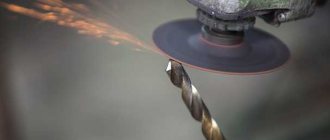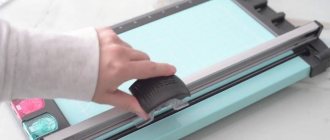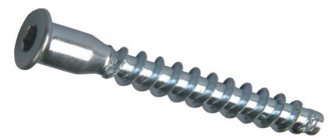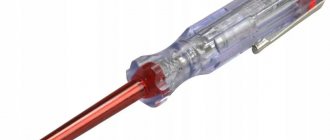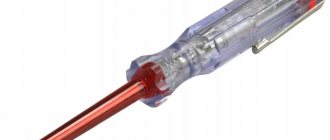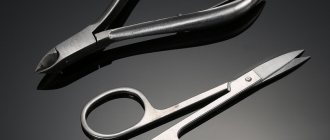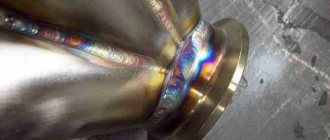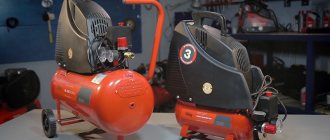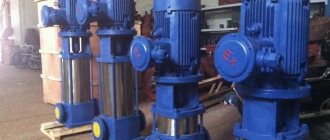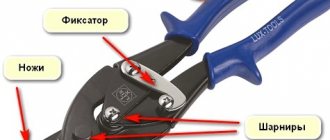Let's consider the key points that you need to pay attention to when choosing a gas cutter for comfortable work.
When choosing gas cutters, you need to decide what thickness of metal you plan to work with:
- Metal thickness up to 100 mm
- Metal thickness from 100 mm to 300 mm
Next, you need to understand what flammable gas you plan to use - acetylene, propane-butane.
Also, pay attention to the design features of the cutters. There are injection, universal 3-pipe cutters, on which you can use replaceable gas mixing mouthpieces for the required type of combustible gas, and kerosene cutters.
Injection cutters have long been known, are familiar to many specialists and are quite widespread. They are distinguished by their simplicity of design - but it must be remembered that due to technological features, such cutters should only be used with a fire-preventing valve installed.
Principle of operation
Metal cutting occurs due to its melting under the influence of a directed stream of oxygen on the line of the intended cut. After melting, the same jet blows out the oxides formed in the cut zone.
The use of gas cutters is effective in the following cases:
- If it is necessary to cut metal structures before subsequent melting during the sorting process.
- To correct defects formed during welding work.
- To eliminate the consequences of accidents.
- In foundry production to correct external defects on finished ingots.
- In metallurgy for cutting metal sheets and rolled products before installing metal structures.
- If necessary, preparation work before welding.
- When dismantling steel structures.
Instructions for use
The preparatory stage consists of inspecting the equipment.
Check that the hoses are connected correctly, that the fasteners are tightened, and that they are tight. It is recommended to lubricate the valve seals with glycerin and then begin work. Cutting steps:
- open the valve with oxygen, then with flammable gas;
- set fire (with a match, lighter) to the resulting mixture;
- regulate the jet using valves to the desired size and flow rate;
- warm up the cutting area;
- open the cutting oxygen valve and perform the operation;
- close the valve with flammable gas, then with oxygen;
- If necessary, cool the tip in cold water.
Open the valves on the cylinders
Open the valves on the cutter
Set the mixture on fire
It is important to remember about PPE - gloves, covered hands, gas cutting glasses, etc. It is advisable to have comfortable shoes, non-synthetic clothing, and completely degrease the cut area, otherwise an explosion when oxygen comes into contact with oil is inevitable. It is not worth reminding that smoking near cylinders is prohibited.
Construction of gas cutters
The cutting torch consists of the following parts:
- Trunk.
- Tip.
- Handles equipped with nipples for connecting gas and oxygen hoses.
- Housings with valves designed to regulate the supply of gas and oxygen.
- Injector.
- Mixing chamber.
- A tube designed to supply oxygen and a combustible mixture.
- A connecting nut that serves to secure the barrel to the body of the device.
During operation of the device, gas is directed through hoses into the product body through nipples. In this case, the combustible gas must flow in a single-flow mode towards the western valve, and the oxygen must diverge into two streams, one of which is directed to the heating valve, and the second to the cutting oxygen valve located outside the handle.
When the oxygen preheating valve is open, gas under pressure is directed into the main injection hole. Discharged flammable gas is supplied to it through a series of peripheral holes.
Once the gases are mixed, they are directed to the mouthpieces through the lower tube of the handpiece.
IMPORTANT! When working with gas equipment, it is strictly prohibited:
- blow oxygen through the propane hose;
- change sleeves with each other.
Oxygen and heating gas are supplied to the tip head, which is removed from the annular gap. After the flame appears, the jet is directed to the site of the intended cut, after which the gas jet burns the metal and removes the by-product in the form of oxide.
To make cutting, the head of the device with the cutting jet is held at a certain distance from the workpiece, after which a narrow slot remains in the processed area, limited by the lateral and frontal planes.
The maximum flame temperature produced by gas cutters running on propane is 2800 degrees. For devices running on acetylene fuel, this figure is 3100 degrees.
What you need to know about paper cutters
In the rush to implement the latest technological solutions in business - artificial intelligence, big data or cloud storage - it is easy to forget that the pace of company development depends on the reliability of the main working tools and equipment. But despite ongoing digitization, large numbers of documents are still printed and stored.
Paper becomes a carrier of important subject or artistic information. For this reason, you should take care of the quality of the content provided. If office work is a daily routine, uneven and crooked edges are unsightly, because aesthetics are very important.
Scissors or a bookbinder are essential office supplies. Of course, they are well suited for occasional cutting, especially small elements and parts. However, over time it may turn out that more is needed.
Cutting a straight line quickly and accurately can be a challenge, especially when dealing with several dozen or several hundred sheets of paper. To do this, it is worth investing in equipment that, in addition to saving time, will ensure cutting accuracy.
A guillotine and a trimmer are two ways to do the same thing. The difference is what we cut, how often, how much and how precisely. Trimmers cut paper into smaller sheets with greater precision. Thanks to the rounded blades, guillotines cut with equal force along the entire length of the page. The sheets do not advance, and the cut edge is smooth, without oblique cuts.
Most people associate the word guillotine with a device created during the French Revolution, where it was used as a form of execution. Currently, no one uses this device; it has a different purpose and in many modern offices you can find a sheet cutter.
This is a popular device that can easily cut large quantities of paper. There is no longer any need to cut individual sheets with scissors and then fold them evenly, which is very labor-intensive.
In most cases, such devices consist of a sharp blade connected to a lever. The device allows you to cut a large stack of sheets in one motion, while the paper will be smooth, without torn edges.
The guillotine is used to cut paper, so it is easy to get an accurate cut on this material. More advanced models can also handle cardboard and thin sheet metal. Most models have a simple structure.
They consist of a base and a lever connected to a knife. The material is cut by moving the lever.
The guillotine makes it easy to fit more paper files to a specific size. Properly cut sheets can be laminated, bound, stored in folders, archival boxes, or sent by mail.
The design of most models is very simple. The equipment consists of a base with a lower knife and a lever with an upper knife. The sheets are cut by moving the lever. The cutter greatly simplifies working with large volumes of documents. It is mainly used in offices, schools and various offices.
Some models may differ in certain parameters. First of all, we need to pay attention to what size paper can be cut using this device.
Most are adjustable in size, but in each case there is a certain size limit. After you specify the maximum size of the material to be cut, you need to pay attention to the number of sheets that the device cuts at one time. The spread here is quite large. Therefore, if we know that we will need more pages, it is worth checking this parameter carefully.
Another important issue is pressure. When using a guillotine, the material must be pressed correctly to allow all pages to be cut cleanly. The simplest models use manual pressure. This means holding the special rail stationary and then pressing the lever. In more advanced products, the device works automatically, i.e. handle with blade. There are also newer models that have additional features such as a laser line pointer, for example.
The size of the device is also important. Which equipment we choose depends, among other things, on the available space. If there are large rooms, we can buy a larger model, and if space is limited, then the choice should be made in favor of more compact models.
There are many devices on the market today, from more expensive, technical and very precise guillotines to common home or small office devices.
When planning to purchase a guillotine, it is worth thinking about what and how often we will use it. Quality is reflected in the price of equipment, but you shouldn’t overpay for something you won’t use 100%.
The key is efficiency, which is determined by the number of pages that can be cut at one time. There are different types of guillotines. For occasional cutting of office supplies or for frequent but less frequent cuts, a simpler model will be useful. Devices of this group are popular, despite the fact that their design is not resistant to large overloads. They have a plastic stand, a knife connected to a lever, and a hand clamp. The number of sheets of paper that can be cut at a time is 5-20. Other types of models have a separate upper blade and sometimes a replaceable lower blade. The tabletop is often made of metal, and the handles are firmly connected to the base, making it resistant to heavy loads. We can cut from 20 to 50 sheets at a time. Guillotines of this type are devices with automatic or lever clamping.
What parameters should you pay attention to when choosing suitable equipment?
Since many cutter models are not automatic devices and require human effort, it would be nice to make this job easier.
Therefore, it is worth paying attention to the ease of use of the guillotine and its effectiveness, as well as the following parameters:
- The cutting length is a very important parameter that determines the maximum size of the paper to be cut. This is important because A3 sheet cannot be guillotine cut down to A4.
- Number of sheets that can be cut at one time - This allows you to know how much paper can be cut at one time. It should be noted that most manufacturers do not recommend constantly working with the tool at the maximum possible load.
- Pressure – The paper must be pressed down before cutting can begin. Most models have manual pressure, that is, the user presses a special bar against the material. However, there is also what is called lever pressure, which allows one lever to be used for this purpose. This is a much more convenient solution. The most developed devices have an automatic lock. It consists of transferring pressure to the bar along with moving the lever with the blade.
- Guard – Every handheld paper cutter should have a guard for the knife blade. This significantly reduces the risk of blade contact with your hand. In its basic form, the lid is a plastic sheet placed between the knife and the countertop. It should be relatively high to protect our fingers even when the knife is in the raised position.
- The lever handle should fit well in your hand. This is especially important in the case of devices that simultaneously cut several dozen sheets of paper. A properly shaped handle will reduce stress on the hand and wrist, and will also help guide the hand correctly during the cut. An additional advantage is that the handle is made of plastic, which has some anti-slip properties (for example, rubberized). It will also increase your grip.
- Non-slip feet are an important element that increases stability (and therefore safety). They should be positioned so that the top of the guillotine does not tilt to the side. Whole legs (or washers) should also be appropriately textured and made from a material that minimizes the risk of slipping.
- Popular formats drawn on the tabletop. There should be not only a ruler on the tabletop, but also basic ISO formats. Thanks to this, we can quickly adjust the paper to the desired size without resorting to additional tables.
- The format limiter is necessary to maintain cutting repeatability. It should slide freely along the horizontal ruler and lock into a fixed position. The lock must be strong enough to prevent accidental movement of the stopper.
- Clamp Bar, Another element that improves accuracy is the clamp bar. It presses our sheets during cutting and thus prevents them from moving. This keeps the cut line straight and hits the same spot for each sheet in the stack; There are two types of clamping bars in guillotines: manual and automatic. The first type works independently of the movement of the blade, the second is activated only when the knife approaches the sheets.
- Robust structure and cutting arm, table top and arm should be all metal. This will ensure sufficient rigidity of the entire structure and reliable fixation of both elements. This also has a direct impact on productivity: a durable device with a good blade can cut more sheets at a time.
- Folding cover, this feature is important if you are going to buy a small guillotine that will be used from time to time. The folding blade cover will make it easier to carry and store the guillotine (for example, in a closet). This is a particularly useful option at home. In this way we minimize the possibility of contact of the guillotine with small children.
Types of gas cutters
Gas cutting equipment is traditionally qualified according to various criteria, but the main ones include the type of combustible material used and the characteristics of mixing gas with oxygen. Also, cutters can be divided according to purpose (specialized and universal), as well as the type of cut produced (separation, surface and oxygen-flux).
Injection
Injection-type devices operate on the principle of intra-nozzle mixing of working gases. This design allows for high reliability and safety of the mechanisms. This is due to the fact that flammable gas and oxygen are supplied to the nozzle through separate channels and mixed in a special mixing chamber immediately before supply.
Injectorless
Injectorless cutters do not have a special chamber for mixing gases. Oxygen is supplied to the nozzle through two channels, flammable gas through a third. The substances are mixed only inside the cutter head. Devices of this type require higher gas pressure to operate effectively compared to injection devices.
So what should you choose?
- Paper cutters designed for home use and small offices
They are the most popular devices. The design of such equipment does not allow heavy loads. Rather, they are intended for occasional or frequent use, but with a small amount of paper. Characteristic features of this type of low-cost solution are a manual clamp, a plastic base and an integrated blade with a lever. Typically, you can cut 5-20 pages at a time.
For large offices and bookbinding shops, more advanced models are required. These devices are designed to operate continuously, often under higher loads. They are characterized by a separate upper blade and a frequently replaced lower blade. The base is usually metal, and the strong connection to the handle allows you to work longer with higher loads. In addition, the number of sheets that can be cut at one time ranges from 20 to 50. This type of equipment often also has an automatic or lever clamp for greater user convenience.
- For professional use
These are the most technologically advanced devices, ideal for printing houses, factories or bookbinding shops. Demanding paper cutters designed to withstand long periods of heavy-duty use can cut up to 500 sheets (a whole ream of paper) at a time. For this type of application, there are also electrical devices that allow automatic cutting.
When choosing a paper cutter, you need to decide where you will use it and how often. Equipment used occasionally and at home does not necessarily have to be high-end and have specialized functions. On the other hand, printing houses, factories and offices require modern, high-quality and expensive devices for professional use.
There is no standard electric or classic guillotine, as each manufacturer offers different solutions. You won't always need all of them, so it's worth taking a look at them. Among them you can find the option of automatic paper clamping. This prevents the sheet from moving during operation.
Standard models also have this solution. It is best to bet on functional, safe equipment with a sharp blade from reputable companies. They offer paper cutters at good prices - both advanced and basic equipment. Remember that the low price is only a one-time saving. Low quality guillotines are more dangerous and have low quality blades. In addition, their security system is not the best. It is also worth checking the opinions of consumers of these devices to be sure that the equipment we are interested in is really worth its price. Make sure it is solid enough, functional and has all the features that make working with it more enjoyable and efficient.
By following the advice in the article, everyone will definitely find equipment that will meet their expectations.
A good office guillotine makes work easier in many companies. It allows you to quickly cut paper, cardboard and other materials. Taking into account the needs of readers, we analyzed the market and user ratings of these devices, and we selected the best models.
Classification according to the combustible gas used
Propane
Propane gas cutters are ideal for processing cast iron pipes and other products made from ferrous and non-ferrous metals. Propane gas cutters are rightfully considered the most reliable and safe and at the same time are able to provide maximum work productivity.
Acetylene
Acetylene gas cutters are used for cutting sheet metal and large parts. Such devices must be equipped with a special valve that regulates the speed and power of oxygen supply to the work area.
Universal
Universal injection-type gas cutters are the most in demand today. These devices allow you to use the power of the working gas if the pressure inside the housing is from 0.03 to 1.5 kgf/square centimeter. The universal cutter is simple and easy to use, has relatively small dimensions and is capable of cutting metal products in different directions. With its help, you can effectively process metal with a thickness of 3 to 300 mm in thickness.
Roller cutter (trimmer or disc)
It is a metal or plastic base on which markings of different formats and a ruler are applied for ease of cutting. On one side of the cutter there is a transparent strip with a recess along which a roller knife mounted in a cassette or handle moves. Paper is inserted under the transparent bar, then a cassette with a roller cutter presses the paper and cuts it. The roller blade can move in both directions from left to right and vice versa. The cutting line is visible through the transparent strip.
Pros of roller cutters:
- Almost all models have a visible cutting line
- has a self-sharpening knife or replaceable blades that are purchased separately
- You can cut paper from 0.5 mm
Disadvantages of roller cutters:
- After a year of use, the cutter may shift the paper and cut unevenly, the error is 0.5-2 mm.
I have a Hama ProCut 460 cutter (made in Germany). I've been using it for about 10 years. The working surface measures 46x15 cm (18 inches), the cutter itself measures 56x20.5 cm. Made of durable plastic. The knife is self-sharpening; when cutting, the blade is pressed tightly against the counter-blade and sharpens it during the cutting process. A transparent plastic bar presses the paper as the knife moves. Cuts paper with a density of up to 300 g/m2. Standard paper sizes are applied to the working surface, there is a ruler in centimeters and inches, lines with degrees 45, 30, 15. The manufacturer states that it cuts 5 sheets of paper with a density of 80g/m2 in 1 pass. In fact, a cutter that has been used for a year or more takes no more than 3 sheets, and a new one takes 4 sheets maximum.
After 3 years of use, when cutting thick paper 300 g/m2, the knife began to jump off the transparent bar; you have to push it back in. After two years, the cutter began to shift the paper by 0.5-1mm. I found a way out - first I put lines on both sides where I need to cut, and then I put it in the middle of the work surface, adjust it along the lines and cut. It turns out smooth. Also, the transparent strip has become loose over 10 years, but this does not interfere with cutting, the cutter presses the paper tightly at the moment of cutting.
Now let's talk about commonly seen roller cutters.
The ProCision paper cutter from Fiskars is designed for cutting dense materials such as chipboard, beer and bookboard, plywood, it also cuts paper and the thickest designer cardboard. Thanks to the double rail system, it cuts paper more accurately and does not allow the blade to “walk”. The blade of the cutter is self-sharpening and does not need to be replaced. Cutting depth 3 mm. It has centimeter and inch markings and is protected from abrasion. Conveniently folds for storage. There is a paper clamp. The cutter itself is heavy.
Trimmer cutter
They come with a straight cut, with replaceable curved blades and a creasing line. Let's take a closer look at cutters from the most famous brands - We R Memory Keepers, American Crafts and Fiskars.
Twist Trimmer Magnetic Combo Pack 16 from We R Memory Keepers . This cutter has 8 disc blades - straight, ripped edge, wave, postage stamp, zig zag, comb, punch and crease line. An attachment with a blade is placed on the magnetic ruler, the ruler is placed on the mat, paper is placed under the ruler and cut. The length of the ruler is 39 cm, has divisions in inches and centimeters. Attachments are sold separately.
Trim and Score Board from We R Memory Keepers 2 in 1 cutter and scoring board. Available in two colors: black with mint and white with mint. The set includes a spare blade, an envelope ruler and a creasing stick.
Pros of the cutter:
- It has a large working surface of 30x30 cm and folds compactly in half
- The ruler is located on both sides with one in inches and the other in centimeters
- Cuts paper up to 250 g thick
Cons of the cutter:
- On the side of the centimeter ruler there is a place to store the creasing stick and because of this part of the centimeter ruler is cut off
- When cutting from bottom to top, the paper gets a little dirty
- Sometimes it cuts unevenly, shifting the paper to the side by 0.5-1 mm
The Portable Cartridge cutter from American Crafts has three replaceable cartridges - straight line, comb and creasing line, the rest of the knives can be purchased in addition. A total of 7 designs were released. There are 6 trays for storing knives on the cutter.
The size of the cutting surface is 20x30.5 cm. Cuts paper with a density of up to 400 g/m2 - scrap paper, photo paper, cardstock and designer cardboard.
If you are using a cartridge with a creasing line, we recommend using one side of the rubber plate along which the knife moves only for creasing. To do this, do not forget to turn it over every time and the fold line will always be straight.
Pros of the cutter:
- All cartridges are closed and can be changed very easily
- Presses the paper tightly
- Has a retractable ruler
Cons of the cutter:
- Sometimes it tears thin paper with a density of 80 g/m2
- It does not press the paper well against the top edge of the cutter and because of this, the cut is sometimes offset by 0.5-1 mm
- You need to press down firmly on the handle with the slider
Fiskars SureCut Paper Cutter - This cutter is also called a rotary cutter. An attachment with a blade is attached to the folding ruler, and a wire (string) is also stretched onto the ruler; it guides the blade when cutting. The nozzle moves up and down along a special recess on the working surface and cuts the paper. Cuts up to 5 sheets of paper with a density of 80 g/m2, designer cardboard, cardstock, scrap paper. The set includes 2 replaceable blades and a creasing attachment. The working surface of the cutter is 16x31 cm, there is a retractable ruler up to 38 cm. Markings in inches and centimeters are applied to the working surface, as well as standard paper sizes A5, A6, A7. The blades of the cutter are protected by a lock. There is a convenient transparent paper holder. Unfortunately, with frequent use, knives quickly become dull.
Pros and cons of gas cutters
The advantages of gas cutters include:
- The ability to effectively process metal with a thickness of up to 300 mm (depending on the modification and operating parameters of the equipment).
- Combustion stability of the exiting flame. The mixture is burned without popping or backfire.
- Ability to work with metal in any direction.
- Efficiency.
- High performance.
- Convenience and ease of equipment maintenance.
- Low cost of devices and components.
The disadvantages include:
- The likelihood of thermal deformation of the material.
- The need to refine the edges formed as a result of the cut.
- High risk of fire.
- Large cutting width, which makes it necessary to maintain allowances when carrying out marking work.
- Cannot be used with stainless steel.
- When working with thick metals, the taper of the cut becomes noticeable.
Tips from experts on working with a cutter
Experienced carvers advise always using high-quality personal protective equipment:
- special glasses;
- gloves (mittens), jacket and pants with fire-resistant properties;
- special work shoes.
The workplace must also be properly equipped. The location of gas cylinders is at a distance of 5 m from hot work. The workshop should be well ventilated, the floor should be concrete or earthen. The flame of the gas-oxygen burner should be located frontally relative to the gas supply hoses. Hoses must not interfere with work.
It is also important to have auxiliary tools and devices for marking work - pencil (chalk), tape measure, square, ruler. To ignite the flame, you will need a special lighter, which the carver should always have at hand.
At the end of the work, you need to carefully inspect the workplace so as not to accidentally step on a piece of molten metal, which can burn through even the thick sole of your shoes. The cut metal blanks are usually left to cool in natural conditions, but if necessary, forced cooling with water is allowed - this must be done carefully so that hot splashes do not get on the skin.
DAHLE 440
The model can simultaneously cut up to 35 sheets of paper up to 3.5 mm thick. The cutting disc itself is made of high-alloy steel, which ensures precise cutting of paper or loose cardboard. The pressure roller efficiently and reliably presses the paper against the counter blade, which provides additional sharpening of the blade. Thanks to this, the knives will last a long time. The cutter is installed on a metal table with rubberized legs. The body has a division scale, automatic clamp, and two corner attachments with a rod.
Pros:
- High build quality;
- Cuts paper accurately and reliably without burrs;
- Sturdy metal table base;
- Sharp knives;
- Durable and high quality cutter.
BULROS 450 VSPLUS
This model is suitable for heavy use and can cut up to 450 sheets of 70 g/m2 paper at a time. The model is made of durable materials and is equipped with a reciprocating cutter. The cutter is equipped with a special electric drive for pressing and cutting, which provides the model with precision paper cutting. The cutter is controlled using a digital control method, as well as a protection system.
Pros:
- There are many cut protection systems;
- Accuracy of paper cutting;
- Digital control;
- Disc brake;
- Additional cabinet included.
Minuses:
- Heavy weight;
- Large dimensions.
FELLOWES ELECTRON A4
The model has an unusual and stylish shape and is equipped with a round knife-blade. Thanks to the mechanical adjustment and direction of the rod, the cut occurs more smoothly and accurately. The knife extends only when cutting paper, so it will be very difficult to cut yourself with it. You can cut up to 10 sheets of A4 or other format at a time.
Pros:
- The special shape increases ease of use;
- Safety of use;
- There is an automatic paper clamp;
- The set includes a cutting unit with a straight and curved cutter.
